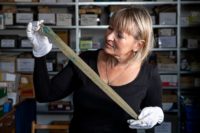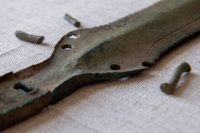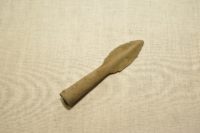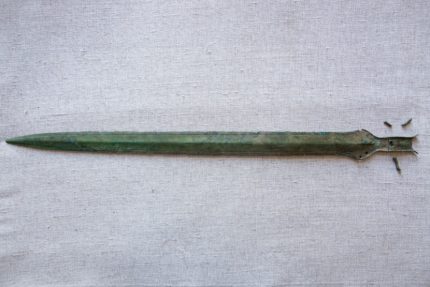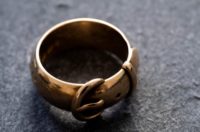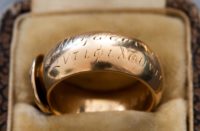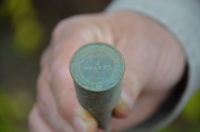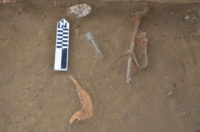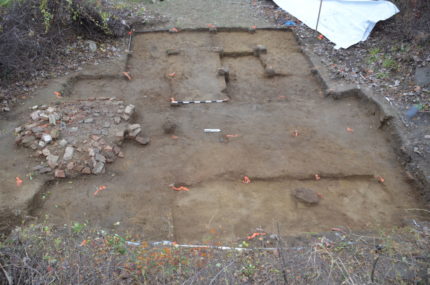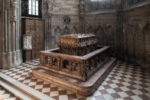 In the Apostles’ Choir of the great Gothic cathedral of St. Stephen’s in Vienna lies the monumental tomb of Holy Roman Emperor Frederick III (r. 1452-1493), the first emperor of many to follow from the House of Habsburg and the last HRE be crowned by the Pope (Nicholas V) in Rome. Made from the prized red marble peppered with fossil inclusions from the Adnet quarry near Salzburg, the massive sarcophagus and platform were carved by Dutch sculptor Nikolaus Gerhaert van Leyden. Gerhaert carved all of the coat of arms of the emperor’s dominions around the side of the sarcophagus and peopled it
In the Apostles’ Choir of the great Gothic cathedral of St. Stephen’s in Vienna lies the monumental tomb of Holy Roman Emperor Frederick III (r. 1452-1493), the first emperor of many to follow from the House of Habsburg and the last HRE be crowned by the Pope (Nicholas V) in Rome. Made from the prized red marble peppered with fossil inclusions from the Adnet quarry near Salzburg, the massive sarcophagus and platform were carved by Dutch sculptor Nikolaus Gerhaert van Leyden. Gerhaert carved all of the coat of arms of the emperor’s dominions around the side of the sarcophagus and peopled it 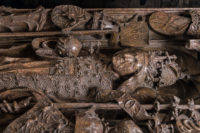 with an incredible proliferation of some 240 figures climbing the edges, peering out from underneath it, and standing in classical dignity on the arches of the platform. It took Gerhaert, his workshop and his successors 50 years to complete the tomb. Frederick’s son Maximilian I had his body moved with much pomp and circumstance from the ducal crypt to the completed tomb in 1513, 20 years after his death.
with an incredible proliferation of some 240 figures climbing the edges, peering out from underneath it, and standing in classical dignity on the arches of the platform. It took Gerhaert, his workshop and his successors 50 years to complete the tomb. Frederick’s son Maximilian I had his body moved with much pomp and circumstance from the ducal crypt to the completed tomb in 1513, 20 years after his death.
The tomb is justifiably considered a masterpiece of late medieval sculpture, and also bore the distinction of being the only one of 14 tombs of kings and Holy Roman Emperors not to have been looted, damaged, altered or its contents moved. That changed in 1969, when a rumor spread that the tomb had in fact been empty all this time. A peephole was drilled into the side of the tomb and officials used lamps and mirrors to confirm that funerary goods and the imperial remains were indeed present.
In 2013, the 500th anniversary of Frederick III’s burial in the tomb, researchers embarked on a thorough study of the tomb aided by modern technology. The little hole was put to use again, this time to thread through endoscopes that lit the dark space and took photographs with a wifi-enabled camera and cellphone. They also took samples, fragments of the coffin and one tiny piece of a textile inside the sarcophagus.
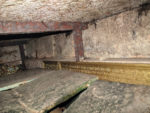 The results of this study six years in the making are being revealed now and they document the most elaborate internment of a medieval European ruler ever found. The photographs capture a sumptuous interior indicating that Maximilian spared no expense on his father’s final resting place. The emperor’s remains were placed a coffin made of glazed ceramic tiles, draped in richly patterned textiles, his
The results of this study six years in the making are being revealed now and they document the most elaborate internment of a medieval European ruler ever found. The photographs capture a sumptuous interior indicating that Maximilian spared no expense on his father’s final resting place. The emperor’s remains were placed a coffin made of glazed ceramic tiles, draped in richly patterned textiles, his 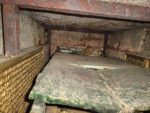 head resting on a pillow. Lining both sides of the sarcophagus are gilded tablets with inscriptions praising Frederick’s many accomplishments and Maximilian’s filial devotion in laying his father to rest “in hoc precioso monomento” (“in this precious monument”).
head resting on a pillow. Lining both sides of the sarcophagus are gilded tablets with inscriptions praising Frederick’s many accomplishments and Maximilian’s filial devotion in laying his father to rest “in hoc precioso monomento” (“in this precious monument”).
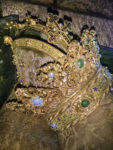 The unexpectedly elaborate imperial crown is made of gilded silver decorated with floral flourishes and vividly colored enamel inlays. It is the oldest surviving example of the mitre-crown that would become standard equipage for the Habsburg emperors when in 1602 Emperor Rudolf II commissioned the imperial crown that would grace all the heads of Holy Roman Emperors and Austrian Emperors until 1918. Its mitred dome and frontal cross were inspired by Papal regalia, symbolizing the emperor’s divine right to his throne and his anointment by the Pope. The crown was placed on Frederick’s skull which had been carefully wrapped in linen and covered with a piece of red fabric.
The unexpectedly elaborate imperial crown is made of gilded silver decorated with floral flourishes and vividly colored enamel inlays. It is the oldest surviving example of the mitre-crown that would become standard equipage for the Habsburg emperors when in 1602 Emperor Rudolf II commissioned the imperial crown that would grace all the heads of Holy Roman Emperors and Austrian Emperors until 1918. Its mitred dome and frontal cross were inspired by Papal regalia, symbolizing the emperor’s divine right to his throne and his anointment by the Pope. The crown was placed on Frederick’s skull which had been carefully wrapped in linen and covered with a piece of red fabric.
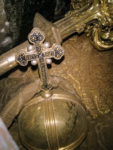 Along with the crown, Frederick was buried with an imperial orb and scepter placed a pillow to the right of his body. These were custom-made for his tomb. They were not the regalia of office. A sword was by his left side, as was a wooden arm that had fallen off a crucifix placed on his chest. The detail of the enamel and metalwork indicates they were produced by Italian artisans.
Along with the crown, Frederick was buried with an imperial orb and scepter placed a pillow to the right of his body. These were custom-made for his tomb. They were not the regalia of office. A sword was by his left side, as was a wooden arm that had fallen off a crucifix placed on his chest. The detail of the enamel and metalwork indicates they were produced by Italian artisans.
 The textiles overall are in remarkable condition. From the photographs and samples, researchers were able to identify three different textiles. The body is shrouded in one (probably linen), and then covered with two large silk velvet panels with silver gilt threads. They too are of Italian manufacture and date to shortly after the Emperor’s death in 1493.
The textiles overall are in remarkable condition. From the photographs and samples, researchers were able to identify three different textiles. The body is shrouded in one (probably linen), and then covered with two large silk velvet panels with silver gilt threads. They too are of Italian manufacture and date to shortly after the Emperor’s death in 1493.
The full findings of the project, In hoc precioso monomento. The Burial of Emperor Frederick III, edited by Franz Kirchweger, will be published by the Kunsthistorisches Museum in December.
